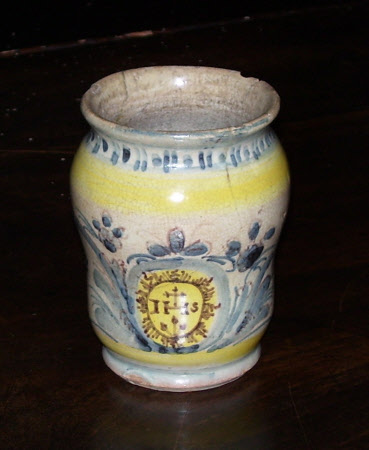Apothecary jar
Category
Ceramics
Date
Unknown
Materials
Earthenware
Measurements
115 mm (Height) x 85 mm (Depth)
Order this imageCollection
Clevedon Court, North Somerset
NT 623900
Summary
Ceramic apothecary jar(?) or vase with tin glazed earthenware, hand? painted with blue and yellow glazes on cream ground, previously marked CLE/C/343. Marked with IHS in central roundel.
Provenance
Note inside the case containing the jar reads 'When the bricked up chapel of Clevedon Court, Somerset was opened up at the end of the nineteenth century, this was found inside and was given to my grand father, who was presented it by Sir ? Ambrose Elton. If the present Lord Elton would like to have it, I wish it to be returned to him.'signed Esme Eve. Enquiries have reinforced the opinion of Bristol City Museum and Art Gallery, that the artefact is in fact an apothecary's jar. Its shape, decoration and general quality suggest that it originated in Spain, or possibly Italy. The decoration on the front is the motif of the Jesuits, an order which commonly provided medical care and operated apothecary services. Later jars were more ornate; lids became the norm and labels were embodied in the decoration. This item has a rim, which was provided to enable a cover of cloth or skin to be secured with string. The date is uncertain, 18th century has been suggested, although it may be that the style had existed for some time before. If EE's account is true, it would suggest that the chapel became disused and concealed, and the jar buried in the wall, in the 18th century. It is much more likely that the chapel was actually altered as part of the substantial 16thC alterations of the house. It was already being called a Lady's room in 1668. It is noteworthy that EE's account does not mention the fire - the most likely occasion for working on the chapel wall - which casts an element of doubt on the story as handed down. Maybe the 'chalice' was indeed given to EE's grandfather by Ambrose - but it is possible that the story of the discovery in the wall has grown, or been altered in an important detail in the telling (eg the item was indeed a wall but not that of the chapel). It seems that putting items into walls at times of building work was common practice - a medieval glass bottle was recovered from the wall after the fire and is still in the possession of the Elton family. Time capsules are still commonly placed in foundations of buildings. As to the origin of the item, it could have been brought to Clevedon by Baldwin Wake when he returned from Spain in the 1600s, although we do not believe that significant building work was done in this period. It could just as well have been acquired in Bristol by one of the Elton family in the 1700s.
